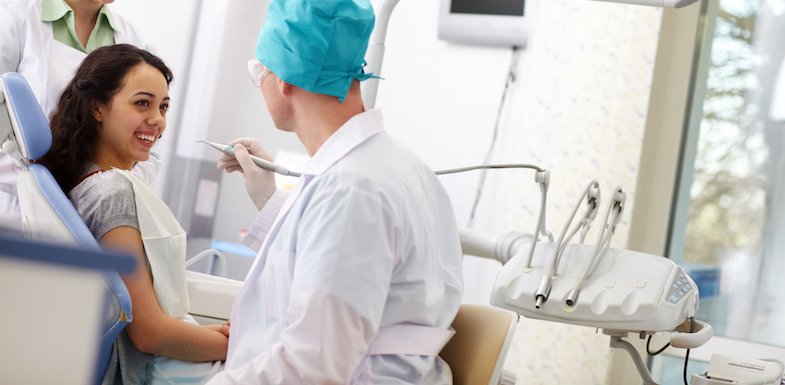In a healthy mouth, tissue and bone fit snugly around each tooth. When teeth are extracted, the bone and tissue left behind has nothing to hold on to. It may begin to deteriorate. In some cases, deteriorating bone may be what leads to extraction to begin with. Guided tissue regeneration, especially after extraction, can help restore tissue and even bone. This protects the rest of the mouth from further damage.
What is guided tissue regeneration?
When a tooth becomes so damaged that it needs to be extracted, damaged tissue and bone is often left behind. Guided tissue regeneration after extraction is a procedure that helps strengthen and regenerate lost tissue. This way, a dentist can perform implants or other dental restorations.
Guided tissue regeneration is usually accompanied by guided bone restoration. Underlying bone loss and deterioration can make it impossible to install implants into the jawbone. Bone grafts encourage new bone growth. They can come from:
- A patient’s own bone
- Bone from a tissue bank
- Synthetic bone material
In most cases, patients will have a barrier erected between the soft tissue and the bone. This can help preserve space for new bone growth.
Who’s a good candidate for guided bone and tissue regeneration?
Guided bone and tissue regeneration has become a common procedure when damage to the jawbone is present. This damage may occur as a result of underlying gum disease. Bone and tissue regeneration may also be used to stimulate new bone and tissue growth after trauma to the jaw.
In the past, periodontal surgeons would simply cut away diseased bone and tissue, but this left very little to work with in terms of dental restorations such as implant-supported bridges or crowns. These days, surgeons can assess the damage and generate a plan for guided bone and tissue regeneration using the i-CAT® (Cone Beam Computerized Tomography [CBCT]). This technology allows surgeons the most comprehensive look at underlying bone structure to determine if guided tissue and bone regeneration is necessary and possible.
As with most surgical interventions, the patients who experience the most success are those who are in overall good health. Guided bone and tissue regeneration is not indicated for the following people and situations:
- Smokers: Smokers who do not quit are unlikely to have a successful procedure
- Underlying wound complications: Inadequate wound healing due to conditions such as diabetes or lack of soft tissue can cause further complications
- Poor oral hygiene: If patients are unwilling or unable to perform proper oral hygiene after the procedure, infection is likely
- Bony or tissue defects: A degree of healthy bone and tissue must be present to regenerate new growth.
With any of the above conditions, complications are likely.
The chances of success improve when patients commit to following all instructions given by the surgeon, both pre-and post-operatively.
What can I expect during a guided tissue regeneration procedure?
A successful guided tissue regeneration begins before surgery. For patients who are concerned about their surgery, a mild anti-anxiety medication may be prescribed. Otherwise, patients are advised to take over-the-counter non-steroidal anti-inflammatory drugs (NSAIDs) like ibuprofen as directed for 24 to 48 hours prior to the procedure.
On the day of the procedure, patients will brush and floss as usual and take any prescribed medications.
Complete sedation for this procedure is usually not necessary, although some periodontal surgeons may recommend nitrous oxide or another mild sedative to relieve patient anxiety.
The procedure itself
For guided bone regeneration, your dentist will make an incision over the site for regeneration. They’ll thoroughly clean and debride loose material at the site. Then, they’ll place the bone graft.
Your dentist will then place a barrier between the gum and the bone, with a small space left for the bone to grow into. This barrier may be made out of a resorbable material that dissolves into the body, or it may be non-resorbable, necessitating a second surgery for removal in about six weeks. After approximately three months, the bone should have filled the space created by the barrier, and further dental restorations can begin.
In the case of guided tissue regeneration, treatment of any underlying periodontal disease must be completed before any procedure is performed. The barrier that is placed for guided bone regeneration also serves as a platform upon which new, healed tissue can be generated. This tissue heals the gum and begins to create the ideal circumstances for successful dental implants. If there is adequate bone but the tissues are still unhealthy or sagging away from an implant, other periodontal disease can arise.
Post-op care
Post-operatively, it is important to follow the surgeon’s instructions exactly. This is especially true when it comes to taking medications and keeping the surgical site clean. In general, the following instructions apply.
- Take all medications as directed, even before swelling and pain are present (this includes antibiotics as well as prescription pain medication)
- Use reusable ice packs or frozen vegetables for 20 minutes on and 20 minutes off for 24 to 48 hours after surgery
- Keep head elevated above the heart to reduce swelling
- Avoid strenuous activity for two or three days following surgery
- Avoid smoking and drinking for two weeks following surgery
- Refrain from eating hard and sticky foods for at least a week
- Limit diet to soft foods and soups (avoid chewing on the surgical site)
Even with proper hygiene and adherence to post-operative instructions, complications can occur. As with any surgical procedure, infection is a possibility, as is the need for further surgery if the first is unsuccessful. Overactive brushing can damage the surgical site, and some patients experience prolonged hypersensitivity.
For many, the benefits of new bone and tissue regeneration far outweigh the possible complications. Working with a compassionate and caring surgeon is the key to successful guided tissue regeneration, especially after extraction.
AZ Dentist is your experienced oral surgeon in the Phoenix area; give us a call today!
